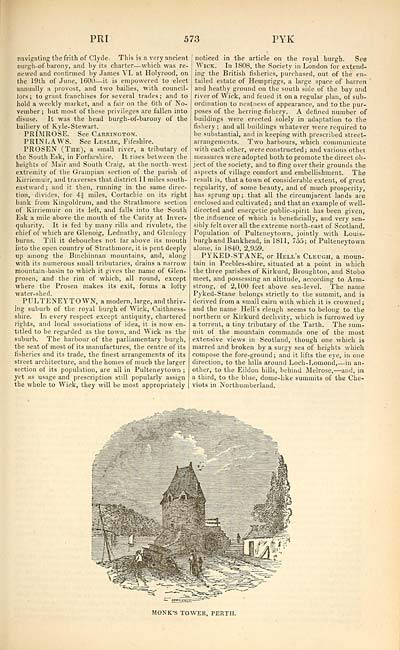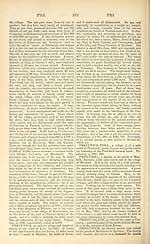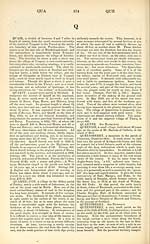Topographical, statistical, and historical gazetteer of Scotland > Volume 2
(589) Page 573 - PRI
Download files
Complete book:
Individual page:
Thumbnail gallery: Grid view | List view

PRI
573
PYK
navigating the frith of Clyde- This is a very ancient
Durgh-of- barony, and by its charter — which was re-
newed and continued by James VI. at Holyrood, on
the 19th of June, 160(3 — it is empowered to elect
annually a provost, and two bailies, with council-
lors; to grant franchises for several trades; and to
hold a weekly market, and a fair on the 6th of No-
vember ; but most of these privileges are fallen into
disuse. It was the head burgh-of-barony of the
bailiery of Kyle-Stewart.
PRIMROSE. See Carrington.
PRINLAWS. See Leslie, Fifeshire.
PROSEN (The), a small river, a tributary of
the South Esk, in Forfarshire. It rises between the
heights of Mair and South Craig, at the north-west
extremity of the Grampian section of the parish of
Kirriemuir, and traverses that district 11 miles south-
eastward ; and it then, running in the same direc-
tion, divides, for 4$ miles, Cortachie on its right
bank from Kingoldrum, and the Strathmore section
of Kirriemuir on its left, and falls into the South
Esk a mile above the mouth of the Carity at Inver-
quharity. It is fed by many rills and rivulets, the
chief of which are Glenoig, Lednathy, and Glenlogy
burns. Till it debouches not far above its mouth
into the open country of Strathmore, it is pent deeply
up among the Binchinnan mountains, and, along
with its numerous small tributaries, drains a narrow
mountain -basin to which it gives the name of Glen-
prosen, and the rim of which, all round, except
where the Prosen makes its exit, forms a lofty
water-shed.
PULTENEYTOWN, a modern, large, and thriv-
ing suburb of the royal burgh of Wick, Caithness-
shire. In every respect except antiquity, chartered
rights, and local associations of idea, it is now en-
titled to be regarded as the town, and Wick as the
suburb. The harbour of the parliamentary burgh,
the seat of most of its manufactures, the centre of its
fisheries and its trade, the finest arrangements of its
street architecture, and the homes of much the larger
section of its population, are all in Pulteneytown ;
yet as usage and prescription still popularly assign
the whole to Wick, they will be most appropriately
noticed in the article on the royal burgh. See
Wick. In 1S08, the Society in London for extend-
ing the British fisheries, purchased, out of the en-
tailed estate of Hempriggs, a large space of barren
and heathy ground on the south side of the bay and
river of Wick, and feued it on a regular plan, of sub-
ordination to neatness of appearance, and to the pur-
poses of the herring-fishery. A defined number of
buildings were erected solely in adaptation to the
fishery ; and all buildings whatever were required to
be substantial, and in keeping with prescribed street-
arrangements. Two harbours, which communicate
with each other, were constructed; and various other
measures were adopted both to promote the direct ob-
ject of the society, and to fling over their grounds the
aspects of village comfort and embellishment. The
result is, that a town of considerable extent, of great
regularity, of some beauty, and of much prosperity,
has sprung up; that all the circumjacent lands are
enclosed and cultivated ; and that an example of well-
directed and energetic public-spirit has been given,
the influence of which is beneficially, and very sen-
sibly felt over all the extreme north-east of Scotland.
Population of Pulteneytown, jointly with Louis-
burgh and Bankhead, in 1811, 755; of Pulteneytown
alone, in 1840, 2,959.
PYKED-STANE, or Hell's Cleugh, a moun-
tain in Peebles-shire, situated at a point in which
the three parishes of Kirkurd, Broughton, and Stobo
meet, and possessing an altitude, according to Arm-
strong, of 2,100 feet above sea-level. The name
Pyked-Stane belongs strictly to the summit, and is
derived from a small cairn with which it is crowned;
and the name Hell's cleugh seems to belong to the
northern or Kirkurd declivity, which is furrowed by
a torrent, a tiny tributary of" the Tarth. The sum-
mit of the mountain commands one of the most
extensive views in Scotland, though one which is
marred and broken by a surgy sea of heights which
compose the fore-ground; and it lifts the eye, in one
direction, to the hills around Loch-Lomond, — in an-
other, to the Eildon hills, behind Melrose, — and, in
a third, to the blue, dome-like summits of the Che-
viots in Northumberland.
— ojm m ggra» -
MONK'S TOWER, PERTH.
573
PYK
navigating the frith of Clyde- This is a very ancient
Durgh-of- barony, and by its charter — which was re-
newed and continued by James VI. at Holyrood, on
the 19th of June, 160(3 — it is empowered to elect
annually a provost, and two bailies, with council-
lors; to grant franchises for several trades; and to
hold a weekly market, and a fair on the 6th of No-
vember ; but most of these privileges are fallen into
disuse. It was the head burgh-of-barony of the
bailiery of Kyle-Stewart.
PRIMROSE. See Carrington.
PRINLAWS. See Leslie, Fifeshire.
PROSEN (The), a small river, a tributary of
the South Esk, in Forfarshire. It rises between the
heights of Mair and South Craig, at the north-west
extremity of the Grampian section of the parish of
Kirriemuir, and traverses that district 11 miles south-
eastward ; and it then, running in the same direc-
tion, divides, for 4$ miles, Cortachie on its right
bank from Kingoldrum, and the Strathmore section
of Kirriemuir on its left, and falls into the South
Esk a mile above the mouth of the Carity at Inver-
quharity. It is fed by many rills and rivulets, the
chief of which are Glenoig, Lednathy, and Glenlogy
burns. Till it debouches not far above its mouth
into the open country of Strathmore, it is pent deeply
up among the Binchinnan mountains, and, along
with its numerous small tributaries, drains a narrow
mountain -basin to which it gives the name of Glen-
prosen, and the rim of which, all round, except
where the Prosen makes its exit, forms a lofty
water-shed.
PULTENEYTOWN, a modern, large, and thriv-
ing suburb of the royal burgh of Wick, Caithness-
shire. In every respect except antiquity, chartered
rights, and local associations of idea, it is now en-
titled to be regarded as the town, and Wick as the
suburb. The harbour of the parliamentary burgh,
the seat of most of its manufactures, the centre of its
fisheries and its trade, the finest arrangements of its
street architecture, and the homes of much the larger
section of its population, are all in Pulteneytown ;
yet as usage and prescription still popularly assign
the whole to Wick, they will be most appropriately
noticed in the article on the royal burgh. See
Wick. In 1S08, the Society in London for extend-
ing the British fisheries, purchased, out of the en-
tailed estate of Hempriggs, a large space of barren
and heathy ground on the south side of the bay and
river of Wick, and feued it on a regular plan, of sub-
ordination to neatness of appearance, and to the pur-
poses of the herring-fishery. A defined number of
buildings were erected solely in adaptation to the
fishery ; and all buildings whatever were required to
be substantial, and in keeping with prescribed street-
arrangements. Two harbours, which communicate
with each other, were constructed; and various other
measures were adopted both to promote the direct ob-
ject of the society, and to fling over their grounds the
aspects of village comfort and embellishment. The
result is, that a town of considerable extent, of great
regularity, of some beauty, and of much prosperity,
has sprung up; that all the circumjacent lands are
enclosed and cultivated ; and that an example of well-
directed and energetic public-spirit has been given,
the influence of which is beneficially, and very sen-
sibly felt over all the extreme north-east of Scotland.
Population of Pulteneytown, jointly with Louis-
burgh and Bankhead, in 1811, 755; of Pulteneytown
alone, in 1840, 2,959.
PYKED-STANE, or Hell's Cleugh, a moun-
tain in Peebles-shire, situated at a point in which
the three parishes of Kirkurd, Broughton, and Stobo
meet, and possessing an altitude, according to Arm-
strong, of 2,100 feet above sea-level. The name
Pyked-Stane belongs strictly to the summit, and is
derived from a small cairn with which it is crowned;
and the name Hell's cleugh seems to belong to the
northern or Kirkurd declivity, which is furrowed by
a torrent, a tiny tributary of" the Tarth. The sum-
mit of the mountain commands one of the most
extensive views in Scotland, though one which is
marred and broken by a surgy sea of heights which
compose the fore-ground; and it lifts the eye, in one
direction, to the hills around Loch-Lomond, — in an-
other, to the Eildon hills, behind Melrose, — and, in
a third, to the blue, dome-like summits of the Che-
viots in Northumberland.
— ojm m ggra» -
MONK'S TOWER, PERTH.
Set display mode to: Large image | Transcription
Images and transcriptions on this page, including medium image downloads, may be used under the Creative Commons Attribution 4.0 International Licence unless otherwise stated. ![]()
| Gazetteers of Scotland, 1803-1901 > Topographical, statistical, and historical gazetteer of Scotland > Volume 2 > (589) Page 573 - PRI |
|---|
| Permanent URL | https://digital.nls.uk/97455658 |
|---|
| Description | Volume second: I-Z. |
|---|---|
| Shelfmark | Map Room Ref.2 |
| Attribution and copyright: |
|

